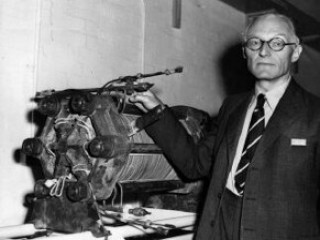
Francis Thomas Bacon biography
Date of birth : 1904-12-21
Date of death : 1992-05-24
Birthplace : England
Nationality : British
Category : Arhitecture and Engineering
Last modified : 2010-05-19
Credited as : Engineer, hydrogen – oxygen fuel cells, Electrical engineering
0 votes so far
In 1959, a quarter of a century later, Bacon and his coworkers were able to demonstrate a practical five-kilowatt system capable of powering a welding machine. Francis Thomas Bacon was born at Ramsden Hall, Billericay, Essex, UK, on 21 December 1904, as a direct descendant of Sir Francis Bacon. He was educated at Eton College 1918-1922, specialising in science and winning the Moseley Physics Prize in 1922 and at Trinity College, Cambridge obtaining a third class in the Mechanical Sciences Tripos in 1925.
He served an apprenticeship at C.A. Parsons & Co. Ltd, Heaton Works, Newcastle upon Tyne, 1925-1928, subsequently working in the Searchlight Reflector and Research and Development Departments at Parsons, 1928-1940. It was while at Parsons in 1932 that he first came to appreciate the potential of the fuel cell and set himself the task of carrying out the practical engineering to prepare the way for it to be considered for commercial application.
This was initially undertaken surreptitiously at Parsons but in 1940-1941 Bacon was able to start full-time work on the hydrogen oxygen fuel cell at King’s College London with the financial support of the consulting engineers Merz and McLellan. Although Sir William Grove had discovered the principle of fuel cells in 1842, they were considered a scientific curiosity until the early 1940s.
Francis Thomas Bacon began experimenting with alkali electrolytes in the late 1930s, settling on potassium hydroxide (KOH) instead of using the acid electrolytes known since Grove’s early discoveries. KOH performed as well as acid electrolytes and was not as corrosive to the electrodes. Bacon’s cell also used porous “gas-diffusion electrodes” rather than solid electrodes as Grove had used.
Gas-diffusion electrodes increased the surface area in which the reaction between the electrode, the electrolyte and the fuel occurs. Also, Bacon used pressurized gases to keep the electrolyte from “flooding” the tiny pores in the electrodes. Over the course of the following twenty years, Bacon made enough progress with the alkali cell to present large scale demonstrations.
From 1941 to 1946 he was temporary experimental officer at H.M. Anti-Submarine Experimental Establishment, Fairlie, Ayrshire, working on ASDIC, the underwater submarine detection system. In 1946 Bacon resumed experimental work on the hydrogen oxygen fuel cell at Cambridge University, first in the Department of Colloid Science, then in the Department of Metallurgy and from 1951 to 1956 in the Department of Chemical Engineering.
This work was supported financially by the Electrical Research Association (ERA). In 1956 Bacon became consultant to the National Research and Development Corporation (NRDC) undertaking fuel cell development work at the Cambridge engineering firm Marshalls where a 6 kW forty cell battery unit was demonstrated in August 1959.
From 1962 to 1971 he was principal consultant to Energy Conversion Ltd (ECL), the first British effort to manufacture fuel cells. From 1971 to 1973 he was Consultant on Fuel Cells to Fuel Cells Ltd, at the Atomic Energy Research Establishment, Harwell. In 1973 he retired though he continued to follow the development of fuel cells very closely for the rest of his life.
Although Bacon hoped to see the adoption of a high efficiency/low pollution fuel cell in everyday applications such as transport, it was in the unforeseen application of space exploration that the Bacon cell achieved its most notable success in his lifetime. In the USA the Pratt and Whitney Division of United Aircraft took out a licence on the Bacon patents and used the concept of the Bacon cell in a successful bid to provide electrical power for the Apollo moonshot.
The fuel cells operated successfully in the manned moon flights and subsequent space applications, providing electricity for the functioning of systems and the production of drinking water. Thus Bacon’s pioneering work may be considered essential to the Apollo programme. By the end of the century, the technology was being developed internationally.
Bacon was elected FRS in 1973 and became an initial Fellow of the Fellowship of Engineering in 1976. He was made an Officer of the Order of the British Empire (1967), elected a fellow of the Royal Society (1973), and awarded the first Grove Medal (1991).
He died in 1992.
















